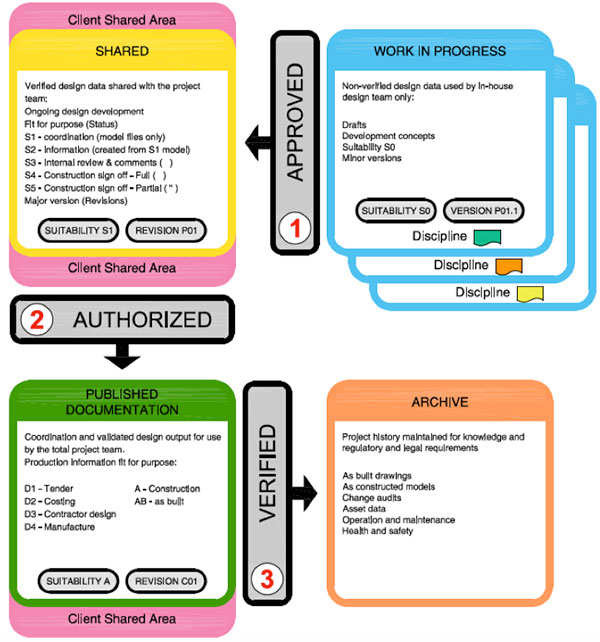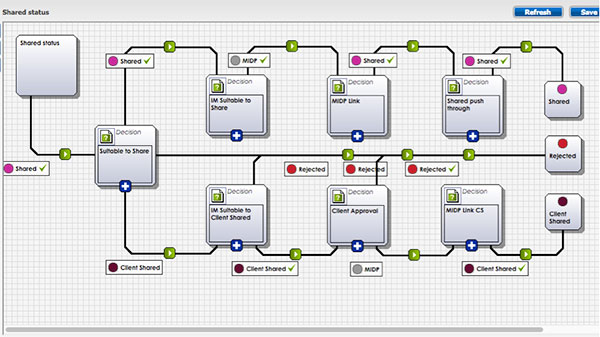PAS1192 Process and Workflows within the Common Data Environment (CDE)
0%
What is PAS 1192?
Back in 2007 BS1192 set out the processes to be followed within a common data environment (CDE) for collaboratively sharing information.
The PAS for 1192-2, the CAP-EX (Construction and Design period) or for PAS1192-3 the OP-EX (the strategic and operational period) both refer back to 2007 and say that the same process must be used for sharing information within the common data environment – and that information is not just models, it’s everything – documents, drawings, data and model files.
The following diagram shows the process to be followed:

Everything starts with Work In Progress (WIP) – and this is only viewable to you and your company. But the standard is very clear that this information should be loaded onto the CDE and this is because the checks and processes of approval within your own company should still be recorded so if at any stage in the future there is a problem it is possible to go back and examine whether those processes actually took place.
Once WIP gets a ‘shared’ status other members of the Design and Construction team can see your work – it may be shared for coordination and clash detection (or any process that requires input from somebody else). You’ve also got the possibility to make your work ‘Client Shared’ – which means that this particular piece of work which is not the finished article is visible to the client for approval or comment.
Once a piece of work has been through the ‘Shared’ process, everybody has made their comments and the work has been coordinated and clash detected it may become suitable for publishing. ‘Published’ means the work is the finished item of work relating to a specific client deliverable – such as a planning application, a construction status document, model or drawing – or any of the other deliverables as defined by the client.
The work could also go to the ‘Client Published’ status which means that it is actually passed over to the client’s asset information system. Or finally, it could go to ‘Archive’ which is when a piece of work has become superseded or out of date.
One of the most powerful tools we have within ‘Viewpoint For Projects’ is our Work Flow Tool and it’s commonly used by design teams and contractors for approval processes and lean work flows too – some of them very complex – and of course we can use it for the 1192 workflow as well.
We’ve worked closely with Mervyn Richards, the author of BS1192, to make sure we have workflows in place which can take you through those various stages – WIP, Shared, Published and Archived. Each uploaded item (model, drawing, document or data) is given a BS 1192 suitability status by the uploader and these link the item to the appropriate workflow.
So here is the WIP workflow:
WIP Workflow within Viewpoint For Projects

You can see that the first thing an uploader does is confirm that they have linked a particular item to the Task Information Delivery Plan (TIDP) of that particular company – meaning it is visible to your team members. There are then two checks – a check for suitability in terms of your CAD Standards and for the suitability of the content – once those checks have been made the item remains on the system as WIP.
This next work flow takes an item which has been given a ‘Shared’ status through a ‘Shared’ or ‘Client Shared’ work flow.

The first node asks somebody to determine whether it should go to ‘Shared’ (your team members will see this) or ‘Client Shared’ (your client will see this too) and then again there are a series of approval stages to go through. At the conclusion of these approvals, a link is made between the particular item being dealt with and the Master Information Delivery Plan (MIDP) – so now everybody knows that this particular item has been delivered at a ‘Shared Status’ to the MIDP – it’s visible to everybody.
Once an item has been through the ‘Shared Work Flow’ it will become visible either to the other members of your Design and Constriction team or if it’s going through the ‘Client Shared’ to the other members of the Design and Construction team and the client.
The next workflow takes a similar process for an item to come through to ‘Published’ – either published as the finished article for your team or published and passed over to the client:
Published Workflow within Viewpoint For Projects

At any stage within these processes, a particular reviewer can reject the item – in which case the uploader will get a notification and will be asked to make certain amendments to that item.
Finally, we have a workflow to take items through to archive:
Archive workflow within Viewpoint For Projects

At the completion of the workflow, each item is linked to the work stage in which it relates which makes for quick and easy viewing.



